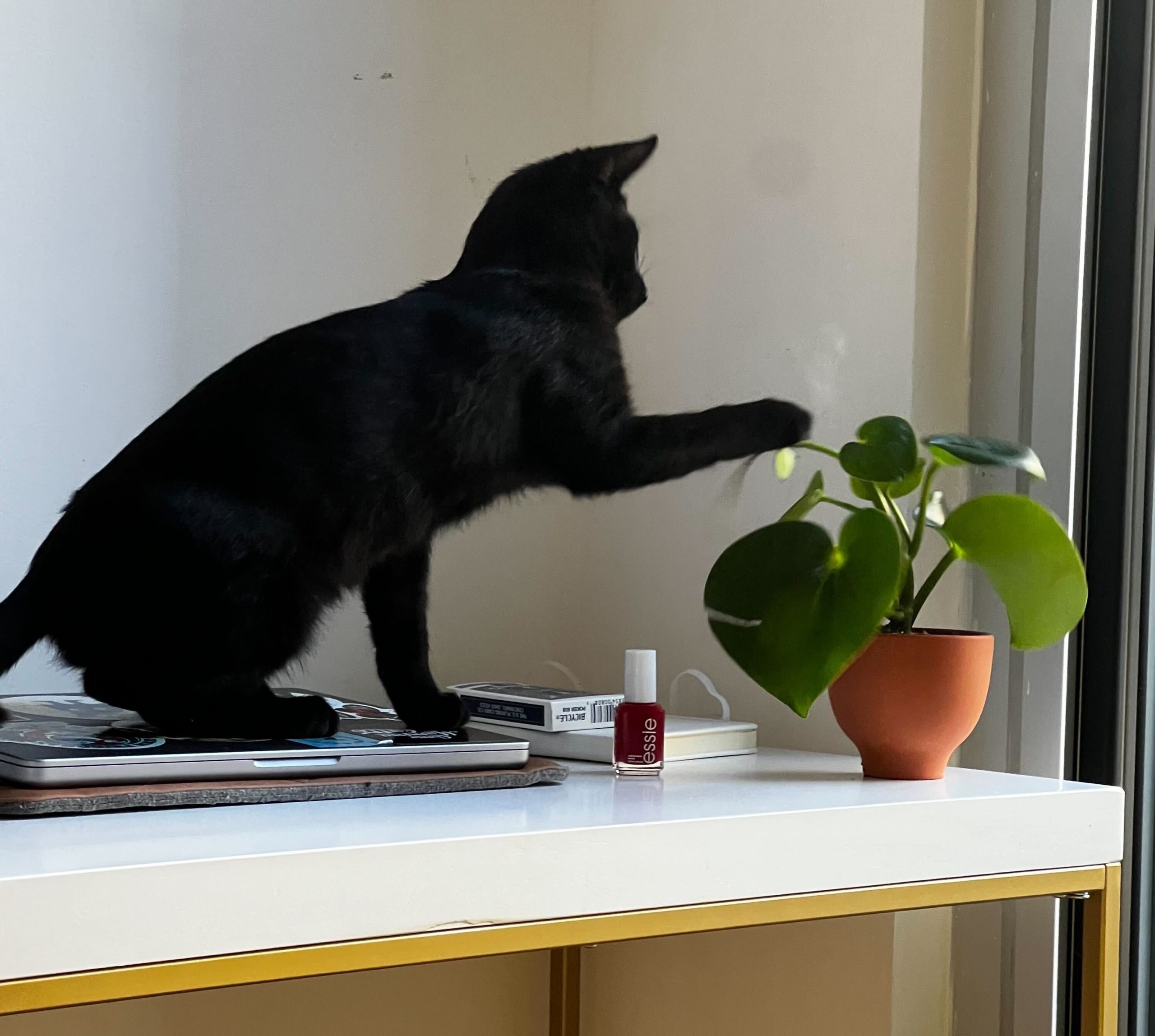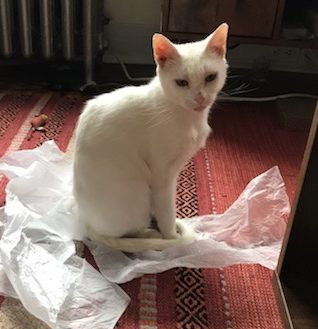
Toxic Plants
There are many plants that are toxic to cats, but many more that are safe. View the ASPCA’s Toxic and Non-Toxic Plants list to learn more. If you suspect your cat has eaten a poisonous plant, contact your veterinarian immediately.
printable list: https://www.aspca.org/pet-care/animal-poison-control/cats-plant-list
https://be.chewy.com/which-plants-are-poisonous-to-cats-a-complete-guide/
https://www.fda.gov/consumers/consumer-updates/keep-lilies-away-your-cats
Other Hazardous Household Items
There are numerous items that pose a threat to your cats. In your house, items such as human medications, poisonous plants and flowers, string, yarn, rubber bands and dental floss are are potential hazards. Ingestion of any of these can be poisonous or cause an intestinal blockage or strangulation. Holiday decorations are also dangerous for kittens and cats, particularly tinsel and lights.
A comprehensive list of both inside and outside items to avoid is available from the Humane Society.
Read more about kitten proofing your home from Hill’s Pet Nutrition.


Common Medical Conditions in Cats
hidden first item
hidden first item
What is the difference between FIV and FeLV?
FIV and FeLV are two important, but often misunderstood, feline viruses that affect cats’ immune systems. If you have a cat who tests positive for either virus, it is important to learn as much as you can in order to keep them healthy.
FIV stands for Feline Immunodeficiency Virus. It is most commonly found in unneutered, free roaming male cats as it is transmitted through deep, penetrating bite wounds associated with true territorial aggression. Once neutered, this level of aggression is uncommon and most FIV+ cats can safely live with FIV- cats. While the virus does affect the immune system, many of cats live symptom free for most, if not all, of their lives.
To learn more about FIV, read FIV – Catching a Bad Case of Rumors.
FeLV stands for Feline Leukemia Virus. It is passed between cats through prolonged, casual contact or from mother to babies. Some cats who are exposed to the virus fight it off while others become persistently infected. Persistently infected cats may live months or years in a healthy state, but many succumb to FeLV-associated disease. Cats who are persistently infected with the virus should not live with FeLV- cats unless they are fully vaccinated against FeLV.
More information about FIV and FeLV is available from Best Friends Animal Society.
For Animals tests all our cats for FIV and FeLV prior to adoption, and we do not euthanize cats based on the presence of the virus alone.
My cat has a urinary tract problem. Now what?
If your cat has urinating outside the litter box, the first thing to do is rule out a medical cause. Urinary tract infections, crystals in the urine and bladder inflammation can all cause inappropriate elimination. The best way to prevent feline lower urinary tract disease (FLUTD) is to feed strictly wet food that is primarily protein (several brands have a “95%” line or the label indicates 95% meat), and avoid fish in your cat’s diet. FLUTD can lead to urinary tract obstruction, also known as a blockage, which can be deadly within 24-48 hours in male cats. If your cat is straining to urinate or making frequent trips to the litter box without producing urine, this is a medical emergency requiring immediate veterinary attention.
If a medical cause for your cat’s inappropriate urination has been ruled out, see “Common Behavior Problems In Cats” above.
More information about your cat’s urinary tract health is available from CatInfo.org.
Do cats get colds?
The most common disease affecting multiple cat populations, an upper respiratory infection (URI) produces cold-like symptoms such as sneezing; runny nose; red, watery eyes; congestion; and loss of appetite. Many of the kittens rescue from the streets by For Animals suffer from URIs and eye infections.
More information about URI is available from VCA Animal Hospitals.
What’s wrong with that cat’s eye?
Eye infections are very common in cats, and can be a chronic condition. Left untreated, an infection can cause permanent corneal scarring or rupturing. Corneal scarring causes a cloudy hue to cover part of the eye, while a ruptured eye generally must be surgically removed. Every year For Animals adopts out cats and kittens with imperfect eyes, and they go on to lead perfectly normal lives!
Read more about eye infections in cats on Petfinder.
Spaying and Neutering Your Pet
hidden
hidden
Why should I spay/neuter my pet?
Nearly 10 million animals are euthanized in shelters each year. Contrary to popular belief, these are not all offspring of stray or street cats. Many animals that wind up in shelters are the offspring of purebreds or family pets who have not been able to find a good home, despite the owner’s and then shelter’s best efforts. By having your pet neutered, you are ensuring that you are not contributing to this enormous burden on our nation’s shelters.
For more information, read about additional reasons to spay or neuter your pet, and learn to separate the myths from the facts.
What if I can’t afford to spay/neuter my pet?
This is now such a standard procedure that it is much less expensive than you’d think! There are also many shelters and veterinarians who offer discounts for rescue cats and kittens.
The Mayor’s Alliance keeps track of many options available in New York City. More information about low-cost spay/neuter options in other parts of the country is available from the ASPCA and the Humane Society of the United States.
Common Behavior Problems in Cats
hidden first item
My cat is not using the litter box!
Eliminating outside of the litter box is frustrating for cat owners, but can also be a sign that your cat is experiencing stress. The cause can be tricky to uncover but the problem is not impossible to overcome. It is imperative that a medical cause be ruled out, as urinary problems are quite common in cats. See “Common Medical Conditions in Cats” below for medical causes of inappropriate urination. Once your cat has been cleared by the vet, there are many resources available to help you.
The Humane Society has published articles on litter box problems and urine marking problems. It is important to understand the difference, as they each have their own causes and treatments.
The ASPCA also has resources for litter box problems and urine marking.
If you are still having difficulty resolving your problem, it may be time to seek professional help. Work with your veterinarian to find a Certified Applied Animal Behaviorist that can help you come to a resolution.
Help! My cat is (fill in the blank)!
Cats are complex social beings who are very sensitive to their environment. Whether you have an ongoing behavior problem, or one that seems to have sparked up overnight, there are a variety of resources available to help you. Note that it is always important to first rule out any medical cause that may be causing your cat’s behavior.
The ASPCA has comprehensive resources for a number of cat behavior issues, from aggression to vocalization.
The Humane Society offers tips sheets on a variety of common behavior problems, including fear, aggression, scratching, litter box problems and more.
If you are still having difficulty resolving your problem, it may be time to seek professional help. Work with your veterinarian to find a Certified Applied Animal Behaviorist that can help you come to a resolution.
Understanding FIP
A comprehensive yet pithy guide and FAQs on FIP – causes, possible triggers, signs, symptoms, currently available treatments, resources and groups for those with FIP-diagnosed cats, plus links to useful articles. FIP stands for feline infectious peritonitis. The disease occurs when a very common (and typically harmless) virus called feline enteric coronavirus (FCoV) mutates within a cat’s body. Please follow this link to access the PDF doc “Understanding FIP” which For Animals’ volunteers compiled to help you. Early diagnosis and treatment is the key, as if left untreated, FIP is fatal.
Since 2001
Saving Animals & Finding Homes
Our History
Since its inception in 2001, the For Animals TNR program has spayed and neutered thousands of cats across hundreds of colonies, and educated dozens of caretakers about proper care for feral cats. During this time, the For Animals adoption program has also placed hundreds of homeless cats and kittens in loving, permanent homes while raising awareness about companion animal homelessness and the importance of spay/neuter.
More Resources
Health & Medical Links
- FIV FAQs
- Debunking FIV rumors
- Study shows FIV+ cats can live safely with FIV- cats
- FeLV FAQs
- FIP drugs continue to show promise
- FIP Warriors FB group
- Why cats should eat wet food
- Don’t feed these people foods
- List of plants toxic to cats
- These essential oils are toxic to cats
- ASPCA Poison Control Helpline for companion animals
- Arthritis in dogs
